Football Running Plays: A Guide to Fundamental Run Concepts
Reading Time: 20 minutes
Reading Time: 20 minutes
Football running plays are essential to establish a strong ground game. If defenses don’t respect your rushing attack, they cheat back and make life more difficult for your passing game. Teams that earn respect on the ground early in the game open up more opportunities through the air.
There are multiple run concepts and even more running plays within each concept. Each running play in gridiron football assigns specific responsibilities to the offensive line and determines what the running back reads and where they’ll run upon receiving the ball.
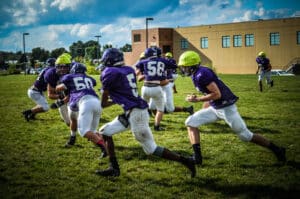
There is no one-size-fits-all or “correct answer” when it comes to running plays in American football. Situational football requires designing specific running plays for different scenarios, like short-yardage situations. Two teams may both run a counter play, but each out of a different formation with completely different personnel and blocking responsibilities. Certain run plays are tailored to backs with a specific skillset while others can be called for a range of running styles.
In this resource, we’ll cover everything you need to know to establish your offensive identity on the ground. Continue reading to learn about the different running plays and concepts at your disposal to incorporate into your team’s strategy.
Football Run Concepts
The types of blocks linemen make, as well as what the running back has to read and make decisions based on, is defined by the type of run concept. A football running concept is designed based on the offensive linemen’s blocking assignments. Multiple types of football running plays fall under each concept.
The three main football run concepts are:
- Man
- Gap
- Zone
Man
A man run concept is straightforward: offensive linemen block specific defenders. Just like the defense lines up head-to-head against their respective opponent in man-to-man schemes, offensive linemen are assigned to block specific defensive players. They know their exact assignment coming out of the huddle.
Gap
Gap running concepts use pre-determined lanes with pulling blockers to create a point of attack. Where man concepts assign specific defenders, gap concepts assign linemen specific gaps before working to the next level.
Precision and coordination from the entire offensive line is key to creating clean running lanes. Coaches use a combination of kick outs, pullers, and lead blocks to create a running lane while the natural leverage of the offensive line blocks away from the run.
Zone
Zone running concepts assign specific areas – or zones – for linemen to block. They know what zone is theirs and adjust to defenders within them. Offensive linemen block in unison and in one direction when running zone concepts. Timing and precision is important.
More of the weight is on the running back in zone concepts. The back has to read the play correctly and select the best path.
Types of Run Plays in Football
Now that we’ve covered the overarching concepts, let’s dive into specific running plays. As we break down the strategy and responsibilities for each play, it’s important to remember that there is no one-size-fits-all, definitive approach to a running play.
- With every football play covered in this resource, there are numerous offensive schemes and formations, personnel groupings, blocking assignments, and other factors that vary depending on the situation, team, coaching philosophy, personnel traits, opposing defensive strategy, and more. You can run them to either the right or left side of the line of scrimmage
- To exemplify blocking responsibilities, each running play will cover hypothetical blocking responsibilities against a 4-3 defensive formation and the visual play diagrams will reflect that.
Some of the most common run plays in football include:
- Dive (Blast)
- Power
- Iso (Lead)
- Counter
- Draw
- Off-Tackle
- Duo
- Trap
- Sweep
- Toss (Pitch)
- Inside Zone
- Outside Zone (Stretch)
- Veer
- Reverse
- Jet Sweep
- Wedge
Dive (Blast)
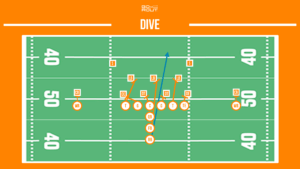
Dive – also known as blast – is a quick hitting, downhill running play. It’s designed between the tackles, typically attacking the A or B gap.
There are two main variations of dive:
- Lead dive: Fullback or H-back leads through gap
- Straight (or Man) dive: There is no lead blocker, the running back runs straight through
When running lead dive, a fullback, H-back, or tight end serves as the lead blocker, clearing a path through the gap for the ball carrier and blocking the first linebacker (or other defender) who appears. The ball carrier receives a quick handoff from the quarterback and follows the lead blocker through the hole they create.
The ball carrier attacks the same A or B gap in man dive, but they don’t have an additional blocker clearing a path.
Because it’s downhill and through the trenches, dive is typically called in short yardage or goalline situations.
Dive (Blast) Blocking Responsibilities Example
When running dive against a 4-3 defensive front, offensive linemen have the following blocking responsibilities:
- Tight end: block play side DE
- Play side tackle: release block SLB
- Play side guard: block play side DT
- Center: block backside DT
- Backside guard: block backside DE
- Backside tackle: release block WLB
- Fullback/H-back: lead block MLB
Coaches can call dive using a number of offensive formations, with I formation the most common. They can also load the offensive line with seven players in jumbo formation when trying to pick up a first down or score a touchdown on the goal line.
Power
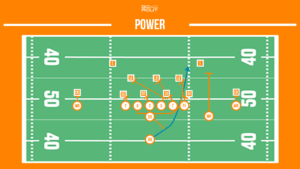
Power is one of the most common downhill gap scheme running plays. It leverages a pulling backside guard to clear a path and create leverage at the point of attack. The play side guard and tackle double-team the play side defensive tackle at the point of attack while the fullback, h-back, or tight end kick-out block the play side defensive end to keep them outside of the running lane.
The combination of blocking responsibilities clears a hole inside the edge on the playside for the ball carrier to shoot through. Typically, the running back hits the inside hip of the pulling guard or kick-out blocker.
Running power requires physicality with strong blocking angles and precise execution to create leverage. It’s a simple, effective play to gain tough yards with the potential for an explosive gain if the ball carrier finds open field.
Power Blocking Responsibilities Example
When running power against a 4-3 defensive front, offensive linemen have the following blocking responsibilities:
- Tight end: kick-out block on play side DE, log block if DE is squeezing
- Play side tackle: double-team play side DT, drive towards MLB
- Play side guard: double-team play side DT, drive towards WLB
- Center: block backside DT
- Backside guard: pull to play side C gap to block SLB
- Backside tackle: block backside DE
Because it attacks the interior of the defensive line, power performs best against teams that stack the outside of the formation with their best players. Coaches can use a multitude of formations to run power out of, both under center and shotgun.
Iso (Lead)
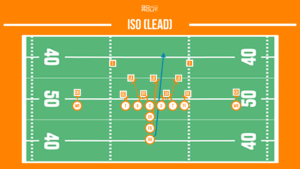
Iso – also known as lead – is a downhill man concept running play that creates a one-on-one block at the point of attack, opening up a running lane for the ball carrier.
Short for isolation, iso is named after its strategy: isolate the middle linebacker so the fullback, h-back, or tight end blocks them head on and clears the path. In iso, the lead blocker and ball carrier aim for either the A, B or C gap, depending on the initial movement of the offensive line.
The lead blocker – either the fullback, h-back, or tight end – knows exactly who they’re blocking before the play begins. That’s what differentiates iso from dive, where the lead blocker contacts whoever is in the way.
On the offensive line, combo blocks control the interior defensive linemen before peeling off to block the outside linebackers. The play side tight end and backside offensive tackle handle the defensive ends.
Iso is another physical downhill running play that requires strong blocking. It’s typically used in short yardage situations or at the goal line.
Iso Blocking Responsibilities Example
When running iso against a 4-3 defensive front, offensive linemen have the following blocking responsibilities:
- Tight end: block play side DE
- Play side tackle: combo block play side DT, then peel off and block SLB
- Play side guard: combo block play side DT and hold block
- Center: combo block backside DT and hold block
- Backside guard: combo block backside DT, then peel off and block WLB
- Backside tackle: block backside DE
- Fullback, h-back, or other tight end: follows through pre-determined gap and blocks pre-determined MLB
Coaches can run iso out of multiple offensive formations, though it is often run under center with at least two players in the backfield.
Counter
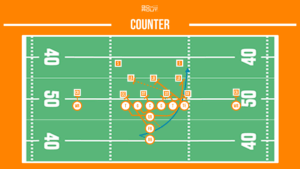
Counter is a downhill gap concept running play built on misdirection to mislead the defense, getting them off balance and out of position. The ball carrier sells fake counter steps towards the backside of the offensive line while two backside blockers pull across the formation to the play side.
Pulling two offensive linemen from the backside – typically the guard and tackle or the guard and a fullback, h-back, or tight end – creates a numbers advantage for the offense. Counter is a versatile, strategic attack that creates clear lanes, has misdirection, and helps the running back get to the second level.
Here’s how the play works, step-by-step:
- The first player to pull is responsible for the kick out block, ideally the downfield shoulder of the defensive end on the line of scrimmage to create a lane for the second puller to wrap through.
- The play side offensive linemen work down blocks and double teams, working toward the backside linebacker. This creates a wall to prevent any backside pursuit.
- The second player to pull wraps through and blocks the play side linebacker, sealing the gap outside
Timing is crucial for a successful counter. The running back uses counter steps in the opposite direction of the play to time things up, but they cannot beat the pullers to the play side or there will be no lane to run through.
Along with timing, the quarterback and running back need to sell their counter movements. The quarterback’s first steps should open towards the backside of the play, selling an inside zone to that side where the running back’s counter steps are directed.
Counter Blocking Responsibilities Example
When running counter against a 4-3 defensive front, offensive linemen have the following blocking responsibilities:
- Tight end: release block MLB
- Play side tackle: back block double team play side DT, work toward backside LB
- Play side guard: back block double team play side DT, work toward backside LB
- Center: downside block backside DT
- Backside guard: pulls to block the play side DE or other edge defender
- Backside tackle: pulls to wrap and serve as the lead blocker for the ball carrier
- Fullback, h-back, or other tight end: Back block backside DE
Coaches can run counter out of many formations, and it can be run to either the strong or weak side.
Draw
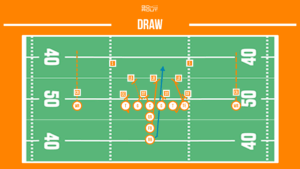
Draw is a football running play disguised as a pass play. It’s meant to deceive the defense into believing the offense is passing, forcing them into their pass drops before handing the ball off to the ball carrier.
The offensive linemen draw back like they’re going to pass protect before driving defenders up and out to create space in the middle of the field. One of the interior linemen, usually the backside guard, climbs to the second level to block a linebacker and create a lane for the ball carrier.
Receivers run clear out routes – like go, corner, or post routes depending on the play – to remove pass defenders and the quarterback drops back to sell the pass, then turns and hands the ball to the running back.
A draw play can be used on obvious pass downs to change the pace of play or to attack when the defense is playing loose in coverage. The goal is to get the defensive linemen charging at the quarterback, getting pushed by the offensive linemen at the last second. It neutralizes aggressive pass rushers, washing them out of their run responsibilities.
Draw Blocking Responsibilities Example
When running draw against a 4-3 defensive front, offensive linemen have the following blocking responsibilities:
- Tight end: block the play side SLB
- Play side tackle: block the play side DE
- Play side guard: block the play side DT
- Center: block the backside DT
- Backside guard: chip the backside DT then climb to the second level to block the backside WLB
- Backside tackle: block the backside DE
- Fullback, h-back, or tight end: block the MLB
Coaches can call a draw out of many different formations. They can leverage a fullback under center or leave the running back as the lone man in the backfield under center or in shotgun formation. Some teams run a draw with an empty backfield, where the quarterback fakes like they’re dropping back before tucking the ball and running themselves.
Off-Tackle
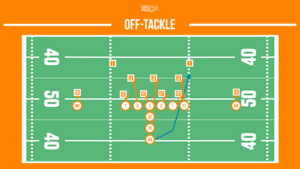
Off-tackle is a running play to the strong side where there’s an extra blocker (usually a tight end). The running back goes to the outside shoulder of the offensive tackle, therefore the name off-tackle.
By loading up the play side of the offensive line and running to the tackle’s outside shoulder, the ball carrier has more freedom to improvise once they are past the line of scrimmage since there’s more open field.
Off-Tackle Blocking Responsibilities Example
When running off-tackle against a 4-3 defensive front, offensive linemen have the following blocking responsibilities:
- Tight end: block the play side SLB
- Play side tackle: block the play side DE
- Play side guard: block the play side DT
- Center: block the backside DT
- Backside guard: climbs to the second level to block the backside WLB
- Backside tackle: block the backside DE
- Fullback, h-back, or tight end: leads to the second level to block the MLB
Coaches can run off-tackle in almost any formation that has a tight-end on the strong side of the offensive line.
Duo
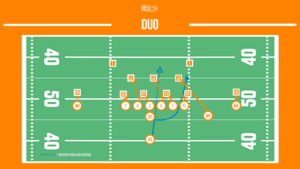
Duo is a downhill running play that leverages double teams on the offensive line and a decisive running back to react to the play. It’s similar to power, but there’s no puller. Duo is always run with a tight end, and it’s always run to the tight end’s side of the offensive line.
It’s a change of pace play that displaces defensive linemen and allows the running back to read the second level. With a patient back and a strong offensive line, duo can create cutback lanes, establish physical presence, and offer big play potential.
Offensive linemen double up, where they double team the defensive linemen directly to the linebacker in front of them. Because offensive linemen are looking for double teams whenever they can get them, duo reduces penetration of defenders and blitzers.
Duo Blocking Responsibilities Example
When running duo against a 4-3 defensive front, offensive linemen have the following blocking responsibilities:
- Tight end: block the play side DE
- Play side tackle: double team the play side DT
- Play side guard: double team the play side DT, react to the MLB and abandon double team if MLB goes inside
- Center: double team backside DT
- Backside guard: double team backside DT, climb to backside WLB
- Backside tackle: block the backside DE
The key to duo is the running back reading the middle linebacker. They’re in charge of making the middle linebacker make the wrong decision by being patient.
Coaches can run duo out of any formation with an extra tight end.
Trap
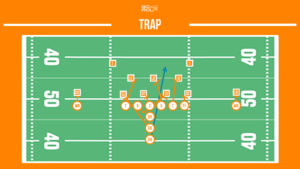
Trap is a quick-hitting, downhill gap concept running play that exploits aggressive defenses and uses a pulling guard to trap a defensive lineman. The running back follows the pulling blocker and hits the hole created by the trap block. It’s a base play in offenses like the Wing-T and I formation.
Running a trap play keeps defenses off balance and mixes up the running game. It forces the defense to react quickly and allows the offense to take advantage of aggressive defensive linemen.
To create deception, the playside guard pretends like they’re pass blocking before leaving their spot and releasing to the middle linebacker. Meanwhile, the backside guard pulls across the line of scrimmage to trap block the unsuspecting defensive tackle or defensive end. The quarterback hands the ball to the running back who hits the open hole created by the trap block.
Trap Blocking Responsibilities Example
When running trap against a 4-3 defensive front, offensive linemen have the following blocking responsibilities:
- Tight end: block the play side DE
- Play side tackle: release block the play side SLB
- Play side guard: influence the play side DT to get them upfield with a quick head fake pass block, then go up for the MLB
- Center: block the backside DT
- Backside guard: pulls to trap block the play side DT
- Backside tackle: release block the backside WLB
- Fullback, h-back, or tight end: blocks backside DE
Coaches primarily run trap out of under-center formations with a fullback, h-back, or additional tight end. It’s not limited to those sets, and can be run out of other formations with variation.
Sweep
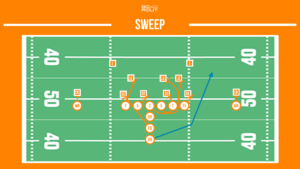
Sweep is a running play that stretches the outside, leveraging two or more pulling offensive linemen. The ball carrier receives the handoff and runs parallel to the line of scrimmage. They must display patience, waiting for the pulling linemen to clear a path and lead the way.
A sweep is used to attack the defensive end, outside linebacker, and cornerback on a specific side of the defense. It can also throw the defense off guard, switching up after pounding an inside rushing attack down the middle. Sweep plays work best when you have an explosive, speedy running back who can turn the open running lanes into big plays with elusive moves in open space.
Sweep Blocking Responsibilities Example
When running a sweep against a 4-3 defensive front, offensive linemen have the following blocking responsibilities:
- Tight end: block play side DE
- Play side tackle: block play side DT
- Play side guard: pull around the edge to release block the play side SLB
- Center: pull around the edge to release block the MLB
- Backside guard: block backside DT
- Backside tackle: release block the backside WLB
- Fullback, h-back, or tight end: serve as misdirection, running to the opposite side of the line as the running back
The linemen that pull can vary. While this example uses the play side guard and the center, the combination of pulling blockers can also include both guards or any other combination of linemen that makes sense for the specific team.
Coaches can run sweep plays out of many different formations. There are also multiple versions, including buck sweep, toss sweep, quarterback sweep, and others.
Toss (Pitch)
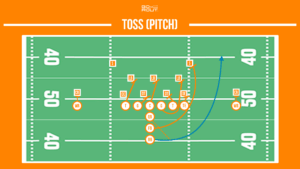
Toss – also referred to as pitch – is an outside run play designed to get around the edge of the defense. It’s similar to a sweep play but instead of handing the ball off, the quarterback tosses the ball laterally or backwards to the back.
To execute a toss play, you need a speedy, explosive running back. The key is to get the ball to the back quickly and create running lanes on the outside of the field. Following their offensive linemen, the ball carrier uses explosiveness to attack the open field created and elusiveness to break away from single defenders in space.
Calling a toss can help gain yards on the perimeter of the field. It also prevents teams from stacking the box for inside runs. If you’ve consistently pounded the run down the middle for most of the game, a toss play can catch defenses off guard. Teams that have a speedy, agile running back can leverage those qualities with toss plays.
Because of the movement outside, toss plays require good timing and precise blocking coordination. The running back needs to be disciplined, waiting for the blocks to open running paths before attacking the hole.
Toss (Pitch) Blocking Responsibilities Example
When running a toss against a 4-3 defensive front, offensive linemen have the following blocking responsibilities:
- Tight end: blocks the play side DE
- Play side tackle: block play side DT
- Play side guard: pull around the edge to release block the play side SLB
- Center: release block the MLB
- Backside guard: block backside DT
- Backside tackle: release block the backside WLB
- Fullback, h-back, or tight end: lead block for running back, clearing out any defender in the running lane
Coaches can call a toss play in many different formations, with or without a secondary back in the backfield.
Inside Zone
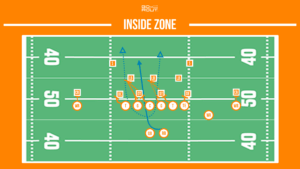
Inside zone is a zone concept running play designed to create running lanes for the ball carrier between the offensive tackles using double-team blocking. It’s a staple of the spread formation offense and utilizes quick north to south running.
Teams can build entire offenses around inside zone, but it’s typically used to create opportunities for the running back to find the best lane based on the flow of the defense. It’s also useful when facing defensive fronts with multiple gaps to defend.
When running an inside zone play, the offensive line uses coordinated lateral movement to move defenders horizontally. Using a two-step process, the linemen step laterally in unison to gain leverage on the play side before moving vertically to move defenders.
The linemen determine blocking assignments by determining if they’re covered or uncovered at the line of scrimmage:
- Covered = a defender lined up in front of them or in their playside gap
- Uncovered = no defender in front of them or their playside gap
Inside Zone Blocking Responsibilities Example
Linemen use zone blocking to cover their immediate area and work together to create double teams at the point of attack. When running inside zone against a 4-3 defensive front, offensive linemen have the following blocking responsibilities:
- Play side tackle: block play side DE
- Play side guard: combo block play side DT up to the playside SLB
- Center: combo block play side DT up to the playside SLB
- Backside guard: combo block backside DT up to the MLB
- Backside tackle: combo block backside DT up to the MLB
- Fullback, h-back, or tight end: kick out block backside DE
The running back needs quick, decisive vision and patience. They read the blocks and defense, looking to find the softest spot in the line, and make a decisive, quick cut. With the inside zone, running backs can make one of three moves: bang, bend, or bounce.
- Bang: Attack the intended running lane and get upfield
- Bend: Cut back inside if the defensive linemen or linebacker gets penetration
- Bounce: Bounce outside if the defensive end gets hooked by the playside offensive tackle
Coaches can run inside zone out of numerous formations with varying personnel.
Outside Zone (Stretch)
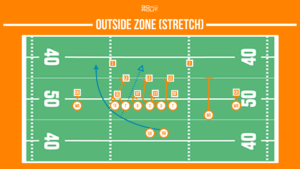
Outside zone – also known as stretch or stretch zone – is a zone concept running play that stretches the defense horizontally. It’s a wider version of inside zone. Instead of running inside the tackles, running backs aim for the outside foot of the playside tackle (or tight end, if there’s one on the line of scrimmage) in outside zone.
Running outside zone puts lateral stress on the defense, opening up cutback options. It creates running lanes along the perimeter of the field and exploits the edges of the defense. Outside zone is a great play to run if you have an undersized offensive line or a running back with speed and agility who makes quick decisions and cutbacks.
Outside Zone (Stretch) Blocking Responsibilities Example
Like inside zone, outside zone uses a zone blocking scheme where each offensive lineman is in charge of an area, not a specific defender. When running outside zone against a 4-3 defensive front, offensive linemen have the following blocking responsibilities:
- Tight end: block play side DE
- Play side tackle: release block play side SLB
- Play side guard: block play side DT
- Center: Release block MLB
- Backside guard: block backside DT
- Backside tackle: Release block backside WLB
As with inside zone, outside zone is a staple of the spread offense but can be run out of multiple formations and personnel groupings.
Veer
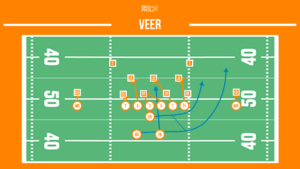
Veer is a zone running concept that leverages two backs and the quarterback as potential ball carriers. It’s regarded as a “triple option” though it is not interchangeable with the triple option.
When running veer – either inside or outside – the three potential options are:
- The first running back in a dive route up the middle,
- The second running back on a pitch route laterally to the outside, or
- The quarterback keeps the ball and attacks the edge.
Veer can be used for teams with undersized players, so double teams and angles can be used to block defenders. It’s also useful to isolate defenders, or take advantage of an undisciplined defense that can’t properly execute their responsibilities.
The offensive line leaves both the play side defensive tackle and defensive end unblocked. The play side defensive tackle has to decide whether to take the dive and the defensive end has to decide whether to cover the pitch.
Veer Blocking Responsibilities Example
When running veer against a 4-3 defensive front, offensive linemen have the following blocking responsibilities:
- Tight end: release block to the play side SLB
- Play side tackle: release block to the MLB
- Play side guard: double team backside DT
- Center: double team backside DT
- Backside guard: release block backside WLB
- Backside tackle: block backside DE
Coaches can run veer out of a variety of formations, though it’s intended to be run out of the split-back formation. It can also be used in I formation and wishbone. High school or college teams run Veer most often.
Reverse
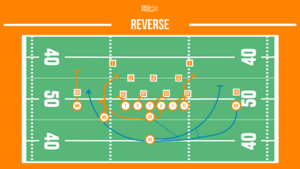
The reverse is a deceptive running play that utilizes multiple ball transfers to confuse the defense. When running a reverse, the quarterback hands the ball off to the running back, who runs laterally behind the line of scrimmage. The wide receiver runs laterally towards the running back and meets up with them, receiving a handoff from the running back to the receiver. The other receivers sell their routes and help block.
Calling a reverse against an overaggressive defense can open up big play opportunities. It can also be beneficial to call after establishing a successful perimeter rushing attack, when the defense is anxious to stop the running back from successfully hitting the outside. If the backside of the defense is honing in on the primary runner, pulling out a reverse can exploit their anticipation.
The offensive linemen block as if the ball were intended for the running back, selling the play to the defense and getting their defenders to follow them.
Reverse Blocking Responsibilities Example
When running a reverse against a 4-3 defensive front, offensive linemen have the following blocking responsibilities:
- Play side tackle: block the play side DE
- Play side guard: pull to backside to lead a path for the wide receiver
- Center: block play side DT
- Backside guard: block backside DT
- Backside tackle: block backside DE
A reverse can be called out of many different formations and personnel groupings.
Jet Sweep
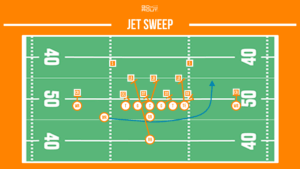
Jet sweep is a deceptive running play that utilizes motion and speedy wide receivers as the primary ball carrier. It involves pre-snap motion to bring a wide receiver across the backfield, towards the quarterback, to take the handoff and run outside.
Teams run jet sweep to attack the perimeter, leveraging the quickness of a wide receiver. The running back in the backfield runs a fake dive route. This aims to trick the defense into focusing on the running back as the primary ball carrier and create open field for the receiver to attack.
A jet sweep can be used to:
- Create misdirection and utilize speed
- Stretch the defense horizontally
- Create potential for big plays
- Set up complimentary plays
- Open up potential for play action pass
Jet Sweep Blocking Responsibilities Example
The offensive line has blocking responsibilities similar to outside zone. When running a jet sweep against a 4-3 defensive front, offensive linemen have the following blocking responsibilities:
- Tight end: release block to play side SLB
- Play side tackle: overtake playside DE
- Play side guard: block play side DT
- Center: release block up to MLB
- Backside guard: block backside DT
- Backside tackle: block backside DE
Jet sweep can be run out of numerous formations, though it’s common to have at least three receivers on the field. It’s wise to have your quickest, shiftiest wide receiver on the field to serve as the ball carrier.
Wedge
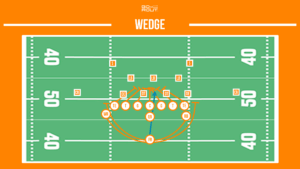
The wedge is a physical running play that generates force to gain tough yards. It requires timing and synchronization on the offensive line to form a wall of blockers and push momentum forward. Wedge is most commonly called for the quarterback or fullback to use the wall of blockers and rush inside.
When running wedge, the offensive line selects a point man (usually the center). The rest of the offensive line slides inside, stepping behind and inside the lineman to the inside, and forms a flying v shaped “wedge” that pushes straight through, shoulder to shoulder.
Wedge is most commonly run out of double wing, wing t, or flexbone formation.
FAQs About Football Running Plays
What are run plays called in football?
Run plays in football are named by the design of the play, strategy involved, and steps necessary to successfully execute it. The way a play is called reflects the direction, blocking scheme, offensive line responsibilities, or other characteristics of the design.
Some of the most common types of run plays in football include dive, power, counter, sweep, and inside and outside zone.
What is the most popular run play in football?
There is no single, most popular type of run play in football. It all depends on your team’s offensive personnel and coaching philosophy, as well as the opponent’s strategy, defensive alignment, situation, and other factors.
A few of the most popular running plays include dive, power, counter, sweep, off-tackle, draw, inside zone, and outside zone.
What are the different types of running in football?
The main types of running plays in football are classified as man concept, gap concept, or zone concept.
- Man concept involves assigning specific defenders to offensive linemen
- Gap concept assigns pre-determined lanes for the offensive linemen to block
- Zone concept assigns areas of space, or zones, for offensive linemen to block
How many plays are run in an NFL game?
In 2024, the average number of plays run by an NFL offense per game was between 58 and 66 plays.
What is the meaning of running play?
A running play is designed to move the ball on the ground, handing it off to a running back who attacks holes created by strategic blocking assignments. Running plays are “on the ground” because the quarterback hands the ball off (or tosses it laterally) to the ball carrier, so it doesn’t travel through the air like on passing plays.
Within the strategy and flow of a game, running plays establish the ability to move the ball on the ground. That way, defenses respect your running game and can’t cheat back to anticipate the pass. Running plays open up opportunities in the passing game, and an ideal strategy is to find somewhat of a balance between running and passing plays.
What is a run play option in football?
A run play option is designed to give the quarterback multiple zone reads, with several options for where to move the ball, depending on what the defense shows.
In a triple option, the quarterback has the option to hand the ball off to a back running a dive, toss the ball to a second back running laterally, or keep the ball and run themselves.
Another variation is a run-pass-option where the quarterback decides whether to hand the ball off to the running back or pull it away and pass the ball through the air.
What is considered a running QB?
A running quarterback usually has speed comparable to a running back. They are often explosive and agile, with the ability to create plays in open space and force defenders to miss.
While they have skills on the ground, they also can attack through the air.
Who decides what play to run in football?
Typically, the head coach or offensive coordinator decides which offensive play to run in football. The head coach or defensive coordinator decides what defensive plays to run, and the head coach or special teams coach decides which special teams plays to run.
Coaches collaborate in pre-game meetings throughout the week to align on their play-calling strategy for each upcoming game.







